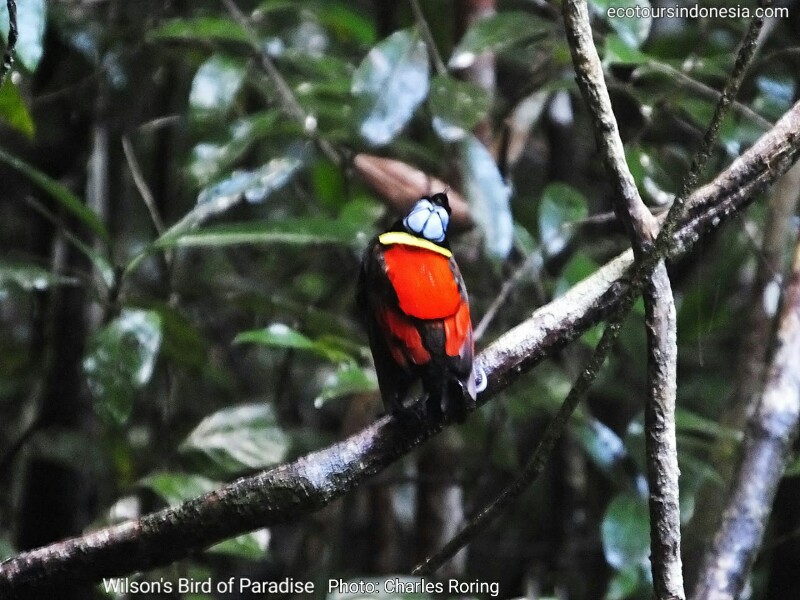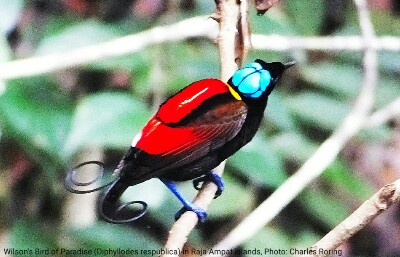Wilson's Bird of Paradise (Diphyllodes respublica) is one of the forty two species of Birds of Paradise known to science. This endemic bird lives in tropical rainforest of Raja Ampat particularly in Waigeo, Batanta and Gam islands. The male one is small approximately 16 cm long. He has got very bright red, yellow and light blue colors with dark green underparts. The female one has got brown feather with similar light blue bald head. The play-grounds of Wilson's bird of paradise are mostly located deep in the forest and on the slope of karst mountains.
Watching Wilsons paradijsvogel

A lot of birders go to West Papua to watch paradise birds and a lot of other tropical birds that live in the forest. Wilson's Bird of Paradise is also included in their target list. To watch the bird, they have to go to Waigeo, Batanta or Gam island. Usually, the distance between the guesthouse and the birding ground is around one to two hours walk. Visitors have to wake up early at 04.00 to make preparation and have early morning tea before local guides bring them to the birding ground of Wilson. From my personal experience, I and some of my clients needed to go by motorized boat for approximately 20 minutes before started hiking for 1 hour to reach Wilson's playground. It looked similar to the playground of Magnificent Bird of Paradise.

Watching other Tropical Birds in Raja Ampat
In addition to Wilson BOP and Red BOP, there are other tropical birds that we can watch such as Spice Imperial Pigeon, Sulphur Crested Cockatoo, Palm Cockatoo, Rufous-bellied Kookaburra, Blyth's Hornbill, Eclectus Parrot, Common Paradise Kingfisher, and Beach Kingfisher. As an archipelago, Raja Ampat islands are the natural habitat of a lot of sea and coastal birds such as Pacific Swallow, Tadorna Radja, Beachstone Curlew.
Birding Devices
Visitors who travel to tropical rainforests such as the ones in Waigeo island need a good pair of binoculars to watch the paradise bird. I personally use a pair of Visionking 10x42 mm binoculars. The binoculars are not the best in the market but they can enhance my birding experience. I have guided a lot of birders who come from Europe, North America and Australia. Most of them bring Swarovski binoculars and spotting scopes. I have tried them and yes, those birding devices are the best. The crystal clear and crisp view of birds that I see through a Swarovski, Leica, Nikon, spotting scope makes me come to this conclusion.
A digital camera with super telephoto lens will be needed if birdwatchers want to take pictures, I used my old camera Fujifilm Finepix HS50EXR. Bringing a tripod is also recommended. It stabilizes the camera.

Swimming, Snorkeling and Diving
Raja Ampat regency as the destination for this birdwatching tour is also a very famous destination for marine related tours. Participants of this birding tour can enjoy swimming and snorkeling too. There is very nice coral reef at the beach which is the natural habitat of hundreds of species of tropical fish including Moorish Idol, Orange Skunk Anemonefish, Red and Black Anemonefish, Pink Anemonefish, Convict Surgeonfish, Parrotfish, Wrasse, and even the Tasselled Wobbegong. There are sea stars, sea cucumber, burrowing clams, Christmas Tree Worm which can be seen as well. A number of Raja Ampat's homestays, beach resorts, and liveaboard dive boats offer scuba diving tour packages for anyone who wants to see pristine coral reef and abundant marine life in deeper water.
Compact waterproof underwater cameras such as Nikon Coolpix AW300, Olympus Tough TG-6, and Sealife DC-2000, can be used to take pictures of these beautiful marine creatures.
Booking your Birding Tour
To book your birding tour in Raja Ampat, please, contact me (Charles Roring) by e-mail to: peace4wp@gmail.com or by whatsapp to: +6281332245180. You could also click the contact link above to book your birding trip to West Papua of Indonesia. - This is written by Charles Roring